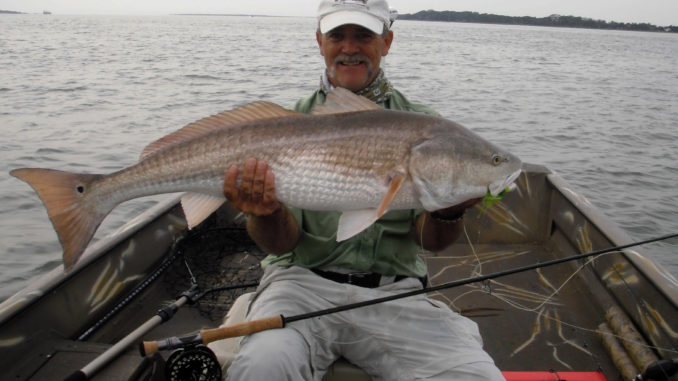
Fresh bait, plenty of current and a nice contour change can mean plenty of action, and maybe a trip to the physical therapist afterwards
October is recognized as National Physical Therapy Month across America, and fishermen planning on visiting Georgetown’s inshore waters will surely need a series of appointments with their favorite physical therapist.
October is the peak month for the fall run of giant red drum into the Winyah Bay region. Within a few minutes of local landings, anglers can expect to hook up with oversized reds from 20 to 50 pounds — easily enough to pull a few muscles.
Red drum, aka channel bass, big reds or bull reds, flood through inlets and into inshore waters to spawn from late August through September. After that, they stay around just long enough to feast on the seemingly endless supply of fresh groceries cascading daily through area waters. The main channels fill with brown and pink shrimp, blue crabs, croakers, spots, menhaden and acres of jumbo mullet. If there was ever a perfect time and location to fill up for the winter, this would definitely be it.
Capt. Steve Roff of Barrier Island Guide Service keeps an eye on these massive fish throughout the year, and he makes sure to take advantage of the beastly season when they are excessively hungry and concentrated in confined places.
“They’ve just finished spawning, and they are eating everything they can get in their mouths,” said Roff. (843-446-7337) “Crab, shrimp and baitfish are very plentiful and stacked in the main channels and around the inlets.”
Water temperatures, which generally fall quickly through October and November, will drive the congregation of fish food out to see toward greener pastures. Unfortunately, the redfish will follow close behind, heading to the reefs, wrecks and other areas off the beach where they overwinter.
“They will fatten up while they are here and then head offshore by the end of the year,” Roff says.
But while the huge numbers of reds are around, anglers can expect to have trips that range from productive to prodigious in a number of places.
“You can find them from the jetties all the way up to Georgetown. Sometimes the bite is even better upstream towards Georgetown than out around the inlet,” he said. “The mullet, crabs and shrimp move up and down the main channel.”
Yet the areas closer to the ocean are the most predictable during October and Capt. Gene Dickson of Delta Guide Service (843-546-3645) will stand behind that claim.
“The bulk of the fish come and go with the tides, mostly following the bait, but as the shrimp crop concentrates in the channel towards the ocean later in the year, the big reds will stay and eat as much as they can,” said Dickson, who will fish just off the main channel through Winyah Bay, along ledges and places where the current is broken by a rise in the bottom contour.
“The fish will lie along little depressions or in small eddies to ambush baitfish and shrimp passing in the current,” he said. .
Roff uses his depthfinder to find humps off the edge of the channel where the water is between 18 and 25 feet deep.
“Fish can be caught on either side of humps during an incoming or outgoing tide,” Roff said, “and the key is to make sure you are right on the bottom.”
The channel towards the inlet in the Georgetown area is known for strong tides and heavy current. Big reds will feed almost exclusively along the bottom and will rarely move higher into the water column. Roff’s parties catch the most fish when the current is rolling strong, and in order to get his baits to the right place, he uses three to four ounces of weight to make sure the groceries are on the bottom.
While a huge push of giant reds flood into the channel at Georgetown, they will patrol other nearby places where anglers can have similar success. Dickson routinely fishes the remote waters of the Santee Delta, specifically, the inlets where the North Santee and South Santee rivers empty in to the ocean.
“Fish will lie right in the middle of the deeper channels cutting through the sand bars in the mouth of the inlets,” he said.
Additionally, the waters along the beachfront just north and south of these inlets will have deep sloughs running close to shore that will be thick with bait. In the fall, reds patrol these sloughs for an easy meal.
Anglers have many options in October, and bait choice is fairly simple. Reds are eating just about everything available, from inhaling live fish, blue crab and shrimp to gobbling up hunks of fish and crab body parts.
Live mullet around five to eight inches long tend to be the bait of choice for manyt anglers, simply because they are the most abundant and the easiest to catch. Schools of mullet and menhaden will be abundant in the back of Muddy Bay, along the ICW near the South Island Ferry boat landing and even along the banks off the channel, within sight of the fishing grounds.
Anglers lacking in cast-net skills should have little to worry about; they can pick up 15 to 20 pounds of fresh spot, croaker, and/or mullet from their local seafood market and have very good success when cut up into manageable, bite-sized pieces. Sometimes, cast netters will capture a few huge, 16-inch mullet — too big to fish whole — and they must turn them into cut bait, too. According to Roff, the big reds are not shy or choosy per se; bites will come more often when cut baits are flowing in the current correctly.
“Make sure the bait doesn’t spin. Good strip baits work well,” said Roff, who will filet a big mullet and stick the point of a big circle hook through the tail, keeping the wider end away from the hook. He will then split the wind end two inches up to keep it fluttering in the current.
A strong leader and sharp hooks are critical equipment. Whether constructed of monofilament or fluorocarbon, leader line from 50- to 100-pound test is recommended, and 4/0 to 5/0 super-sharp, octopus-style circle hooks are preferred. Leader lengths should be between six and 16 inches to keep the baits near the bottom and to prevent deep hooksets.
Anglers ready to tackle one of these majestic brutes inshore around Georgetown will have their best chances in October. A seemingly endless supply of the big fish will be stacked in familiar waters. Make sure to get plenty of bait and terminal tackle, and most importantly, don’t forget to eat a big, hearty breakfast before the action begins; for a day of muscle-burning action is just a short ride away.
Then call that physical therapist.
DESTINATION INFORMATION
WHERE TO GO — Georgetown is south of the Grand Strand and north of the Charleston area, easily accessible from US 17 along the coast and from US 701 and 521 from inland. Two main public boat ramps are the South Island Ferry southeast of Georgetown on South Island Rd. and the East Bay Park landing at the ballpark in downtown Georgetown. Bull reds can be found from the tip of the Winyah Bay jetties inland as far as Georgetown Landing Marina. The best action is along the channel between the Georgetown Lighthouse and the intersection of the ICW closer to Georgetown. On the ocean side, North Inlet, the jetties, the Santee Delta and all of the beachfront in-between are ideal places to find trophy redfish during the fall.
WHEN TO GO — Trophy redfish begin trickling into inshore waters in late summer; they’ll be in large schools from mid-September through November, but the peak fishing in the WInyah Bay channel is through October. As regular cold fronts move in, fish will move out of the channel, first stopping around the inlet and beachfront, and then making their way offshore.
BEST BAITS/TECHNIQUES — Live mullet and/or menhaden are preferred baits for bull reds, especially in the 6- to 8-inch range. Smaller baits, including pieces of cut blue crab and shrimp, will draw strikes from bull reds, but from every other species in the water. Fresh cut bait are acceptable if live bait is ineffective or unavailable. Fileted mullet strips flow the best in the current. Carolina rigs are preferred with 3- to 4-ounce egg sinker and six to 12 inches of 50- to 100-pound mono leader and a 4/0 to 6/0 circle hook. Shorter leaders will cut down the chances of deep-hooking fish. If you use artificials, go with large bucktails (5/8- to 1-ounce) with 6-inch soft-plastic trailers in white, chartreuse or other natural colors. Weighted artificial flies from eight to 10 inches long can be used in chartreuse and white. Medium-heavy to heavy spinning or baitcasting outfits with a high capacity spool are needed to crank in the large fish in a hurry. The main line can be between 30- and 40-pound mono or 50- to 60-pound braid.
GUIDES/FISHING INFO — Capt. Steve Roff, Barrier Island Guide Service, 843-446-7337 or www.barrierislandguide.com; Capt. Gene Dickson, Delta Guide Service, 843-546-3645. Also, see Guides and Charters in Classifieds.
ACCOMMODATIONS — Georgetown Area Visitors Center (www.visitgeorgetown.com); Myrtle Beach Area Convention and Visitors Bureau (www.mbchamber.com), South Carolina Association of Visitors Bureaus (www.discoversouthcarolina.com).
MAPS — Navionics, 800-848-5896 or www.navionics.com, Waterproof Charts, 800-423-9026, www.waterproofcharts.com; SeaLake Fishing Guides, 800-411-0185, www.thegoodspots.com.

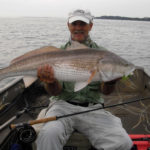
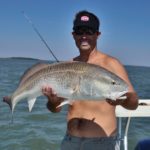
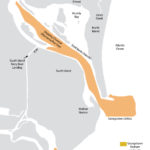
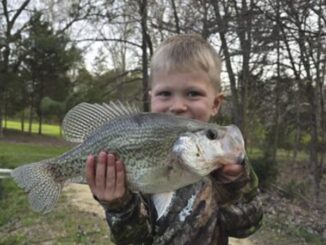
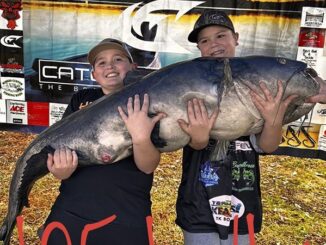
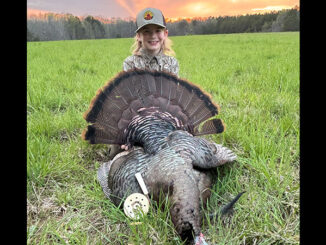

Be the first to comment